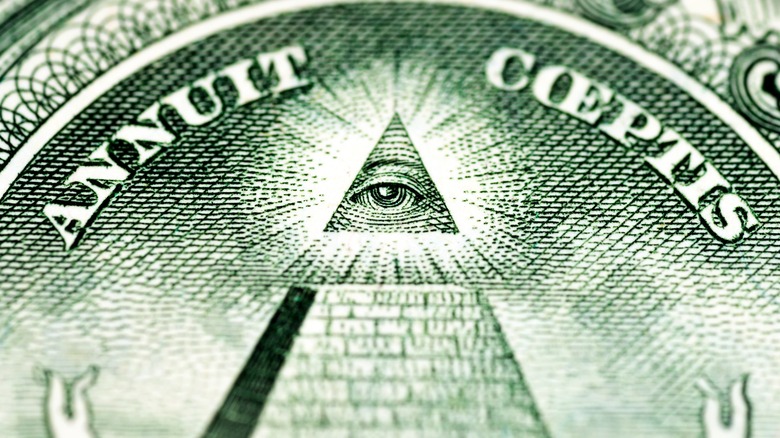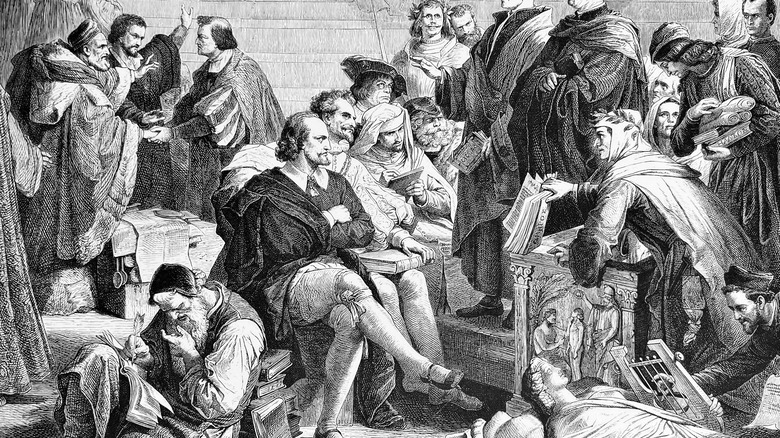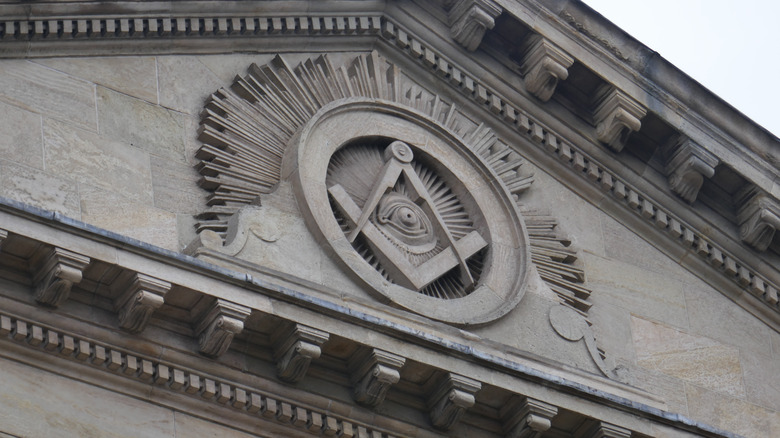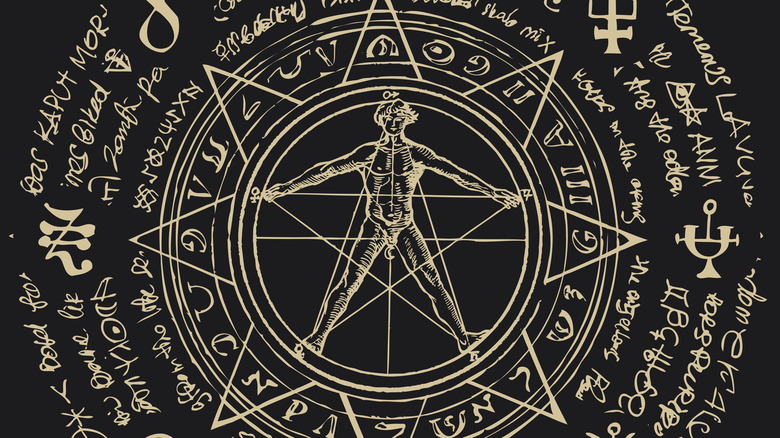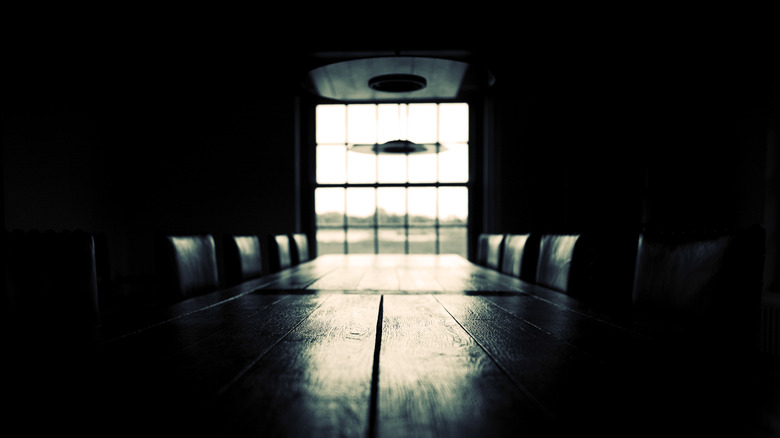How The Illuminati Founder Leveraged Freemasonry To Start His Secret Society
The funny thing about secret societies is that everyone knows about them. At one end of the conspiratorial spectrum we've got hush-hush gatherings like Bohemian Grove, an extended networking luncheon for the global wealthy that involves some low-quality cosplay at a big owl statue in the woods. On the other end we've got the Freemasons, a widely publicized bro-only order of fancy ring-wearers who mostly just process down aisles and donate money to charities. And in the middle we've got the Illuminati, a name that everyone's heard of and associates with "Eyes Wide Shut"-style sex orgies, weirdos in masks, celebrities doing that upside-down triangle hand gesture at the camera, and that eye-pyramid on the back of the U.S. dollar bill.
Well, as fun as all that stuff is to speculate about, reality is far more mundane. The Illuminati not only do not congregate in deep underground lairs around round tables while stroking white cats behind the ears and speaking in low, ghoulish tones about world domination, but they also had some recruitment problems back in the day. As Wondrium Daily explains, the Illuminati's founder, Adam Weishaupt, really wanted high-quality recruits for his terribly-named Order of Perfectibilists in the late 1700s. Sadly, he couldn't reach out to his second-degree connections on LinkedIn and had to resort to some secret society infiltration and espionage. As Heritage Daily tells us, Weishaupt joined the Freemasons in 1777 and used their Masonic Lodge as a base through which to collect initiates into his own secret society.
The wave of the Enlightenment
Before we go any further: Yes, the Illuminati actually existed. They're not a product of fiction. But all the dark, secret collusion that folks typically envision when hearing their name? That most certainly is fiction. As the British Library overviews, the Illuminati was just one of a bunch of similar gentleman's clubs-meet-high society think tanks that cropped up during Enlightenment-era Europe from roughly the late 17th century to early 19th century, like the Freemasons. Such groups rode the cultural wave of the time that laid the foundation for every single facet of modern, Western society: The right of the individual to be self-governed and pursue personal happiness, the separation of church and state, empiricism and the scientific revolution, the power of reason to elevate humanity, and so forth. The U.S. Founding Fathers were Enlightenment thinkers to a T, and the country's 1787 constitution a distillation of the age.
As National Geographic quotes, Illuminati founder Adam Weishaupt wanted a world free "from all religious prejudices" that "cultivates the social virtues; and animates them by a great, a feasible, and speedy prospect of universal happiness." He wanted to help create "a state of liberty and moral equality, freed from the obstacles which subordination, rank, and riches, continually throw in our way." Weishaupt, born in 1748, was a law professor at the University of Ingolstadt in Bavaria, part of modern-day Germany. And come 1776, he started recruiting the best and brightest of his students.
Illuminating the soul
Adam Weishaupt founded the Order of Perfectibilists in 1776. He must have recognized the unfortunate name choice early on, because he rebranded his outfit the Order of Illuminati two years later in 1778. The name "Illuminati" comes from the word "illuminate," as Weishaupt sought to illuminate the human soul and bring about heaven on Earth. In theological terms, he wanted to "immanentize the eschaton," or create an earthly utopia. The National Catholic Register explains how such goals oppose traditional theology because Christians, by definition, believe that perfection is God's and not anything doable by people. And so we have the whole passé "science vs. religion" debate that arose during the Enlightenment.
But when we say that Weishaupt "founded" the Illuminati, he didn't sit at a bank signing LLC documents and getting a business tax ID. As National Geographic describes, he took the theatrical route and called his four students to a ceremony in the woods outside of Ingolstadt where they stood "bathed in torchlight" and swore fealty to the group. Presto: instant conspiracies for the next 250 years. And just for the record, the Scottish Rite explains that the famed eye-in-pyramid symbol is the Eye of Providence. It symbolizes the "Grand Architect" — as Freemasons say — watching over humanity. Then in 1777, Weishaupt did what any self-respecting secret society founder would do: crimp from the big players in town. He joined the Freemasons and used them as a recruitment platform.
A Masonic copy-paste job
Initially, National Geographic says that Adam Weishaupt formed the Iluminati in part because he was "disillusioned" with fraternal groups like the Freemasons and wanted an alterative. As Heritage Daily explains, he formed his secret-within-a-secret society within the Freemasons just to make connections. Once on the Masonic inside he pitched the Illuminati to other Masons as a kind of "pure masonry" to recruit the educated and lofty-minded. It worked, and by 1784 he'd gathered as many as 2,500 converts, many of which had "duke" and "count" in front of their names.
But Weishaupt didn't recruit by himself. One of his biggest game-changing members was the German diplomat Baron Adolph Franz Friedrich Ludwig Freiherr von Knigge (yes, all of that). As the BBC says, von Knigge helped the Illuminati not only expand into Masonic lodges throughout France, Italy, Hungary, Poland, and elsewhere, but outright take them over. Then ironically, von Knigge overhauled the Illuminati to adopt a 13-tier, three-class Freemason-like path to ascendancy. Levels had names suited to modern fantasy role-playing games, like Initiate, Minerval, Illuminatus Major, Priest, and Magus.
Von Knigge's rise to power with the Illuminati helped the group grow, yes, but also caused the group to fracture, as he and Weishaupt locked horns about the Illuminati's direction. At the same time the Bavarian government got suspicious of secret societies, and within 10 years of its creation, the Illuminati was no more.
The Rosicrucian rivalry
In the end, the Illuminati's use of Freemasonry spelled its own doom. While the Illuminati was expanding, Heritage Daily says that founder Adam Weishaupt tried to steer the group away from the Rosicrucians, another Enlightenment-era secret society. The Rosicrucians, which exist to this day, take a more mystical, magical stance on the whole secret society thing, as The Rosicrucian Order website depicts. Once Illuminati members successfully leveraged Freemasonry to infiltrate society's upper crust, the Rosicrucians branded them as dangerous political radicals and worse: atheists.
The nail in the coffin for the Illuminati's short-lived life came after Baron von Knigge — the man who helped the Illuminati expand — got ejected from the group after losing his power struggle with Weishaupt. Shortly after, another ex-Illuminati, Joseph Utzschneider, wrote to the Grand Duchess of Bavaria with anti-Illuminati claims that mirrored the Rosicrucians' claims. In 1784, the Bavarian church forced Duke Karl Theodor to ban any unsanctioned fraternal groups in the country. The Illuminati didn't concede, and Theodor issued further, stricter bans in 1785, 1787, and 1790.
Bavarian police found Illuminati documents in 1785 defending heretical things like abortion and women clergy. Come 1787 these were used as grounds to levy the death penalty against Illuminati members. Adam Weishaupt lost his job at the University of Ingolstadt, was exiled, and got work at the University of Göttingen in Saxony.
The conspiracy lives on
When we say that the Illuminati disappeared in 1787 when the Bavarian government outlawed them, lovers of all things conspiratorial might reply, "That's just what they want you to think." After all, maybe Illuminati members in Masonic lodges across Europe stuck around and did a better job at living up to the "secret" part of secret society. Regardless, the Illuminati's decade-long recorded existence is a perfect cautionary tale of the dangers of overreaching. Rather than let the group grow naturally over time and gather together like-minded people in an organic way, Adam Weishaupt and his members manipulated and inveigled. They progressed too high, too quickly, and paid the price while groups like the Freemasons and Rosicrucians suffered nothing. This all happened very in conflict with the Illuminati's notions of behavior fitting a utopian paradise.
While in exile in Saxony, Weishaupt had the last word — lots of words, in fact. He published numerous books about his once-secret, then-banned society: "Complete History of the Persecutions of the Illuminati in Bavaria" (1785), "A Picture of Illuminism" (1786), "An Apology for the Illuminati" (1786), and "An Improved System of Illuminism (1787)." He died in 1830. Before then in 1797 and 1798, Jesuit priest Augustin Barruel and British professor John Robison kicked off the conspiratorial musings by claiming that Illuminati members were the secret hand behind the French Revolution, of all things. From there the whispers snowballed all the way to the present.
